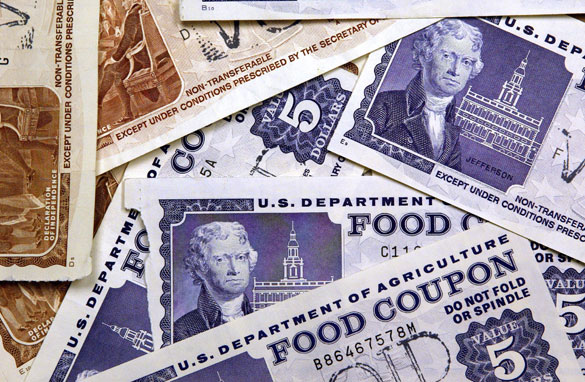Editor’s note: Congress returns from recess Monday, Sept. 9. It then has three weeks to decide how much money to allocate to the food stamp program, or there will be no money available for the program to help feed the poor. To help set the stage for the policy debate this month, reporter Renée K. Gadoua took the SNAP Food Stamp Challenge: living for a week on the amount of money available to those in the program. Read her story, and consider whether you think the benefit is overly generous. Consider also whether it should be federal policy, if they’re spending too much in Washington, to target programs that provide support for the least fortunate among us.
Rabbi Daniel Fellman’s young son looked at his father’s dinner plate earlier this year and asked, “Daddy, why are you eating poor people’s food?”
“I explained that not everyone could go to the store and pick out what they wanted,” said Fellman, spiritual director at Syracuse’s Temple Concord. “And I was doing it so I could learn how to help them more.”
Fellman was among about 30 clergy and dozens of their congregants who participated Jan. 27 to Feb. 2 in CNY Hunger Project/SNAP Food Stamp Challenge, organized by InterFaith Works of Central New York. The challenge involves spending $35 (the average weekly allowance in the food stamp program—officially the Supplemental Nutrition Assistance Program, or SNAP—for a single person in New York) on all food and drink consumed in a week.
Many elected officials and community leaders have taken the challenge to draw attention to the need for food aid for growing numbers of Americans as safety net programs become pawns in partisan budget battles. Newark Mayor Cory Booker did it in December; in June, then-candidate for Syracuse Common Council Dan Cowen and 30 others gave it a try. In June, 30 House Democrats tried it. (Rep. Dan Maffei, Syracuse, has not taken the challenge but said he plans to do so.)
Fellman, who follows kosher dietary rules, ate a mostly vegetarian diet. He bought a pound of ground turkey.
“There was a striking lack of fresh fruits and vegetables,” he said. “The smaller amount you have to spend does not always mean good nutrition. Those sorts of choices I took for granted are not possible for someone on a limited budget.”
His experience taught him that it’s possible to live on the food stamp budget. But it has limitations. “It was never a question of feeling sated,” he said. “It was a question of doing it nutritionally and having what I want.”
I took the Food Stamp Challenge July 29 to Aug. 4. Like Fellman and others, I found that you can buy plenty of food for $35. But it wasn’t necessarily stuff I liked, or stuff that’s good for me. As a reluctant and unimaginative cook, I found the challenge frustrating, and boring. I bought a package of ground beef, but put back the chicken breasts, which cost almost $5. I ate a lot of sandwiches and pasta, and zucchini and squash became staples.
I couldn’t afford soda or juice (let’s leave the debate about sugary drinks for another time, shall we?), so I opted for tea and made jugs of iced tea. In the real world, I would not have to buy a box of teabags every week, but this week it cost me $1.99. A cup of tea at most cafes runs $2. My favorite latte, at about $5, was out of the question. Ten dollars or more for a box of cups for my Keurig? Fuggedaboutit.
After a battle with my conscience, I conceded that peanut butter and Nutella are not condiments, so I could not eat them during the challenge. Pesto is not a condiment, either, I decided with some disappointment.
With a clear limit on spending, I couldn’t just order a pizza or pick up something on the way home. I turned down dinner at my sister’s house. And I postponed plans for a mini family reunion. (Food for thought: The night after I finished the challenge, I had dinner with a group of relatives at a chain restaurant on Erie Boulevard. My entrée alone cost more than $17 – almost half the SNAP allowance for a week.)
Rev. Tiffany Steinwert, dean of Syracuse University’s Hendricks Chapel, described experiencing increased stress during the challenge.
“I had to be very careful about what I purchased,” she said. “We all have budgets, but we don’t usually micromanage our budgets that much. But if you have SNAP benefits, you do.”
She thought about the difficulty of trying to shop without a car. She also noted additional challenges of stores like Price Rite and Aldi.
“Neither of those places gives you bags,” she said. “At Wegmans, you would never have to put in a quarter to get a cart.”
A lower budget meant time preparing food for Steinwert. She found canned beans too expensive, so she bought dry beans, which must soak in water first.
“I was spending six hours preparing the beans,” she said. “One day, I didn’t plan properly and planned to take beans and rice to work and was up till l a.m.”
The careful planning and limitations of a SNAP budget must be exhausting, she said: “If you are doing this week in and week out, that takes a toll.”
On July 11, the House of Representatives passed the Farm Bill that, for the first time since 1973, cut food stamps completely. All 196 Democratic House members (including Maffei) opposed the bill, highlighting partisan differences about government’s role in aid programs and pitting urban and rural legislators against each other.
The Senate on June 10 passed its version of the Farm Bill in a 66-27 vote. The Senate bill cut more than $4 billion over 10 years from the food stamp program.
Fellman and Steinwert, who co-chaired InterFaith Works’ Hunger Project, are disappointed in potential cuts to SNAP benefits.
“When people in Congress want to have debates or ideological confrontations, the poor become the scapegoats,” Steinwert said. “It’s either you support the poor or you throw them under the bus.”
The number of households in Onondaga County receiving SNAP benefits has increased from 17,331 at the end of 2007 to 32,981 at the end of July 2013, said Sarah Merrick, executive deputy commissioner of social services for the county. A total of 63,873 people receive SNAP, and of the households getting the benefit, 10,545 also have earned income.
Merrick acknowledged that some of the increase in SNAP cases results from a federal push to get people on food stamps. The dramatic increase might also reflect a Jan. 1, 2008, rule change that eliminated an applicant’s assets from the eligibility formula. Now only income is considered.
Still, Merrick said, much of the increase in SNAP cases can be attributed to the economy.
“Look at 2008. That’s when everything started collapsing,” she said. “The next three years was a dramatic increase. The economy was definitely part of it. The recession hit a lot of people. This was an effective way to help a lot of people.”
The slowly improving economy is helping. “The caseload isn’t going away. But the increase isn’t as fast as it was,” she said.
Like the 48 million Americans who receive SNAP benefits, county officials will await word from the federal government about changes. The Farm Bill expires Sept. 20. Congress returns to Washington Sept. 9 after a five-week summer recess.
“We’re just carrying on and continuing to qualify people under the rules,” Merrick said. “We continue business today as we know it.”
Maffei blamed the tea party for the congressional bill eliminating food aid.
“A minority controlling the agenda believe government assistance is wrong,” he said. “My worry is what Romney said about the 47 percent (of Americans dependant on government) is much more widely believed than a lot of people would like to believe: that the poor deserve it, that there is a percentage of people who don’t want to work.”
He’s appalled that the House bill eliminated food stamps, but he said a compromise could include a cut in benefits.
“I would be as bad as the other side if I would refuse to entertain a compromise,” he said. “I’m really going to look to my constituents. I pledged to ACTS (the faith-based group Alliance of Communities Transforming Syracuse) that I would fight to avoid cuts. I take that seriously.”
Meanwhile, people in need are threatened with more hardship should benefits decrease or disappear.
“The real tragedy here is we’ve got the people most disadvantaged and most vulnerable caught in the middle of the budget war,” Maffei said.
Rabbi Fellman agrees.
“This is a societal problem,” he said. “We have a responsibility to look out for those who do not have a voice and speak out for them. For a week, I was able to walk in their shoes at least a little bit.”
Follow Renée K. Gadoua on Twitter @ReneeKGadoua.
What I bought, July 29 to Aug. 4
Price Rite
Price Rite Honey Oat Clusters cereal: $1.99
Price Rite rotini: $0.79
Salada black tea bags: $1.99
Rinaldi meat sauce: $0.99
Special-K strawberry cereal bar: $2.49
Loaf wheat bread: $0.99
1.25 lb. ground beef: $4.58
3 cucumbers: $1.77
5 apples: $2.48
Package American cheese slices: $0.89
Sliced ham: $2.99
Half-gallon skim milk: $1.49
Subtotal: 23.44
Downtown Farmers Market
3 zucchini: $1.00
3 squash: $1.00
Package cherries: $2.50
Subtotal: $4.50
Target
Six chocolate donuts: $1.99
Half-dozen eggs: $0.86
Subtotal: $2.83
McDonald’s
3 items from Dollar Menu: $3.00
Subtotal: $3.24
=====================
TOTAL SPENT: $34.01
Take the Food Stamp Challenge
- Spend a set amount for all food and beverages for a week. (Average benefit for single person in New York is $35 a week.)
- Include all food and beverage purchased during the week, including fast food and dining out.
- Eat only food you purchased for the challenge. (You may use spices and condiments you bought before the challenge.)
- Avoid accepting free food from friends, family or at work, including receptions or events where food is served.
— Source: Food Research and Action Center, www.frac.org
[fbcomments url="" width="100%" count="on"]









